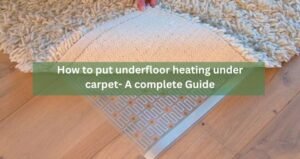Rugs can bring warmth, style, and personification to the room. You can use rugs to make an interior look comfortable and rich. This can be done by layering pattern rugs to add texture in your desired spaces. Rugs may, however, cause a nuisance when they are over a wall-to-wall carpet. They either slip and slide or get worse while posing hazards.
When your carpet just insists on moving, whatever how many times you readjust it, there is nothing to be worried about. And you are not alone. It happens to be one of the most encountered concerns of layered interior styling. In this blog, we’ll learn some practical solutions to avoid sliding of rugs while keeping the floor safer.
Why Do Rugs Slide on Carpet?
The placement of a rug atop the carpet might seem simple, but in most cases, it becomes a headache. To fix the problem, it is necessary to know its causes:
Low Surface Friction
Carpet fibers are soft and offer minimal resistance. Unlike hardwood or tile, carpeted floors don’t provide the grip necessary to hold a rug firmly in place.
Pile Direction Conflict
In case you have a plush or high-pile carpet and rug, the plush surfaces may slide over one another, and this would move the rug or buckle it.
Frequent Foot Traffic
There are rooms that are being used intensively like the living room, the hallways, and the playrooms. These rooms usually have higher traffic because of the use of the rugs on foot or because it is being vacuumed continuously.
Rooms with high usage, such as living rooms, hallways, and playrooms, tend to experience more movement, especially when rugs are stepped on or vacuumed regularly.
Lightweight Materials
Rugs or runners that are thin, or thinner ones made of cotton, man-made materials, and ones that are built in flat weaves, will more often tend to raise and curl along their edges.
You can put into effect one or a combination of the following ten solutions by isolating the issue that is causing the problem in the first place.
10 Smart & Stylish Solutions to Prevent Rugs from Sliding
1. Use a Rug Pad Designed for Carpet
The best way of ensuring that the rug does not move around on Carpet in Dubai is by placing a rug pad specially designed to be used on carpet to carpet. Same are pre-calculated to clasp the two surfaces and not to harm the backing.
Benefits:
- Prevents slipping and sliding
- Adds plushness underfoot
- Reduces wear and tear on the rug
- Protects your carpet beneath
- Extends rug life and maintains its shape
Choose a felt-based or polyester-blend rug pad designed for indoor layering. Brands like Gorilla Grip, RugPadUSA, or Mohawk Home offer excellent carpet-specific options.
2. Apply Double-Sided Carpet Tape
Double tape can work for preventing rugs from sliding. This is the most affordable and quick fix method which adheres the rug directly to the carpet. Make sure, the tape is not much sticky and should not leave any residue after removal.
Pro Tips:
- Apply the tape in an “X” or border pattern for best grip.
- Test on a small corner of the carpet first to check for residue.
- Avoid using on shag or plush pile rugs.
Tape is a perfect solution for smaller rugs, bedside mats, or entrance runners that need to stay fixed.
3. Try Rug Anchor Grippers
Rug grippers are small pads that stick to the rug corners and grip the surface below using rubber suction or hook-and-loop fasteners (like Velcro).
Why They Work:
- Discreet and nearly invisible
- Ideal for corners that curl up
- Perfect for apartments or rentals
Grippers work best on flat-weave or medium-pile rugs placed over short-pile carpets in Dubai.
4. Choose Rugs with Non-Slip Backing
Laying out some rugs that have rugged backing of latex or rubber will be a wise option. These rugs are non-sliding Shaggy Rugs which are supposed to remain on their position regardless of the material beneath them.
When you feel that it is not ideal to replace your rug, a non-slip rug backing spray will be helpful. It reinforces without altering the feel or design of a rug.
The technique is quite convenient when it comes to the children’s bedrooms, home offices, and even other rooms where frequent traction is essential.
5. Layer with a Larger Rug
Rug layering is used frequently by interior designers for functional and decorative use. Simply having a smaller sized rug over the larger textured one (jute or a sisal base) you are also adding friction and eliminating abrasion or slippage.
Design Tip:
- Use a bold, patterned rug on top of a neutral jute base.
- The larger rug anchors the smaller one without adhesives.
- Choose low-pile bases for better grip and easier cleaning.
This adds dimension, color, and warmth while keeping everything stylishly in place.
6. Use Furniture as Anchors
You can avoid the sliding by putting the sides of heavy furniture on Office Carpets. This is the efficient solution to prevent sliding. You can place some portions of your rugs under heavy furniture like a dressing table, a double bed, and sofas, etc.
Caution:
- Avoid putting too much weight on it as this could result in indentations.
- Keep rotating rugs every month to avoid uneven wear.
This method is ideal for your home’s spaces where large rugs are installed.
7. Velcro Strips or Hook-and-Loop Fasteners
To have a solution that can be reused and suited to a rental environment, you can apply Velcro on the rug and carpet. These screws hold strongly without breaking the floor or a rug.
Application:
- Sew or glue one strip to the rug corners.
- Stick the corresponding side to the carpet using carpet-safe adhesive.
Velcro works best for smaller rugs or entryway mats that experience frequent shifting.
8. Install Carpet Seam Tape Underneath
Often used by professionals during carpet installation, seam tape can also be used creatively under rugs. Apply it sticky-side-up in a crisscross or grid pattern beneath the rug.
Ideal for:
- Heavier area rugs in high-traffic spaces
- Rooms where a permanent solution is preferred
Use with caution, as some types of seam tape may be difficult to remove from delicate carpets.
9. Opt for Heavier Rugs or Layering
Light rugs are easy to move and handle. But heavier rugs crafted from thick and dense materials that resist movement. You can also layer a heavy backing rug underneath you a good looks and for extra grip and comfort for the foot.
Heavier rugs, aside from looking fantastic, stay vibrant longer and have a much better wear rate.
10. Avoid Placing Rugs Over Thick, Plush Carpeting
High-pile carpets, like those found in bedrooms or lounges, are incredibly soft but don’t offer the best base for rugs. Instead, try:
- Limiting rugs in plush carpet areas
- Choosing larger rugs that cover more surface
- Using dual-surface rug pads for added grip
When layering over thick carpet, you’ll likely need a combination of at least two of the methods above.
Final Thoughts:
A lovely carpet adds coziness and warmth to your house without being an annoyance or a trip hazard. In a family room or a cosy bedroom corner, one needs to keep their rug in place, as it is essential to bring comfort and safety.
There are luxury carpet-to-rug pads and inventive one-stop homemade solutions; something to accommodate any style and budget. Finding the ideal grip, weight, and location combination for your particular environment is crucial.
Looking for Expert Rug Styling in the UAE?
In Rugs and Carpets, we provide a hand-picked range of non-slip rugs, custom-made model rug pads, as well as professional styling services. We cover everything from layering of rugs over carpet to interior floor plan refresh.
Call our interior design services now or come or visit our showroom in Abu Dhabi or Dubai to have a convenient recommendation and get practical advice.






